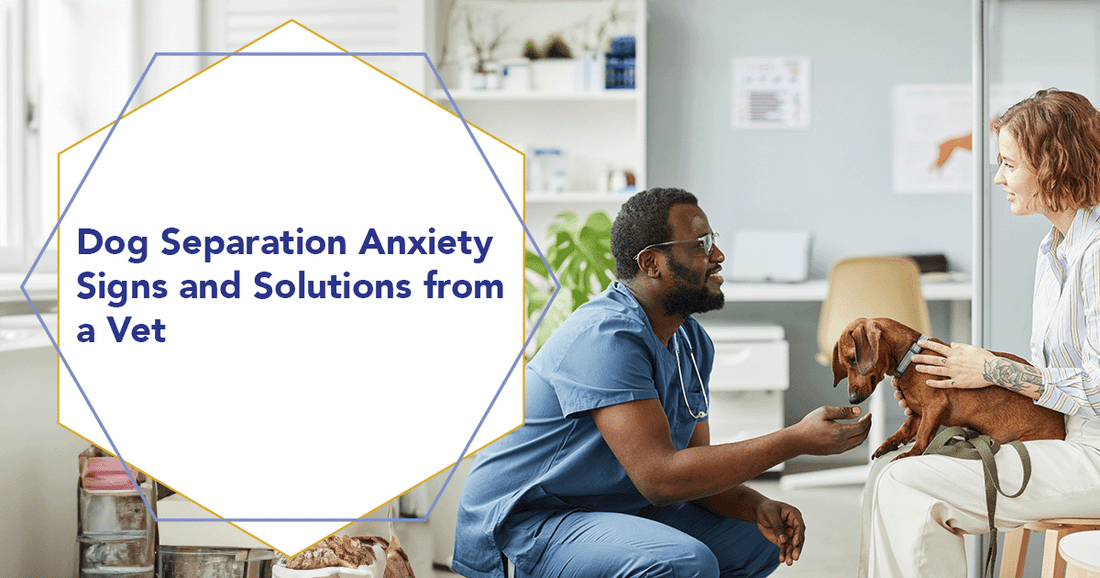
Dog Separation Anxiety Signs and Solutions from a Vet
Share
Separation anxiety is the most common type of anxiety in dogs which makes sense because just like you feel your dog is part of your family, they likely feel you are part of their pack. With that said, in many cases the human is the predominant care giver and the K9 is reliant on them, so when the human isn’t there to feed, validate, and give companionship, the dog may feel intense emotions.
There are studies like this one from Frontiers and this one at the NIH that try to examine the relationship from the dog’s point of view. But just like humans, your furbaby is unique and likely has a special bond and special need just like a human. That's why we created this guide.
It is meant to help you determine the cause of the separation anxiety in your dog, identify the symptoms, and then look at starting points to help reduce your puppers symptoms so they can live their best life.
The Causes of Separation Anxiety in Dogs
The first step is to look at the way your dog was introduced to your home.
- Adoption from a breeder as a puppy
- The dog was a parent at the breeder or a puppy mill
- Adoption from a rescue society or shelter
- Foster dog who now has their forever home, but bounced between
- An abused animal that is now rescued
When the dog comes from a breeder or a puppy mill, the newborn puppies may not be very impacted mentally because their time in the previous situation was short. If your dog was the breeding parent then they likely suffered losing their babies multiple times, and in the case of a puppy mill were abused.
Now that they have a safe place where they can live happily, and with a person who cares, they likely don’t ever want to lose that feeling of security and that causes the separation anxiety. It is similar to a fear of the unknown, what happens when you're not right in front of them or leave through the door and they cannot sense you.
It is similar for a rescue dog that was a stray or a pet that was surrendered to a shelter. Shelter life is not easy, and finding a forever home builds a feeling of security. Once the shelter dog has their parents and best friend, they don’t want them to leave because a dog does not understand when you say you’re only gone for 15 minutes or will come back right after work.
And that is one of the main factors in helping relieve the issues with separation anxiety in dogs. A dog cannot understand English well enough to know that you’re only going to be gone for an hour or until evening. Human children will know you’re coming back even if they miss you, but your dog has no way to actually understand. But there are things you can do to help them predict your return by developing habits and signals.
The Symptoms
The symptoms of separation anxiety in dogs include:
- Clingy behavior and being over affectionate
- Abnormal amounts of cuddling, licking, and jumping on you
- Changes in eating habits when you are about to leave or first return home
- Extreme vocalizations that are not warranted by door knocks or sensory triggers
- Bringing you gifts as you come home
- Having an accident by the door or in a spot that is scented like you as they spend time there
- Excessive time spent by the door you leave or left through
Determining the Triggers and Reducing the Separation Anxiety Symptoms
Each trigger and type of separation anxiety in your dog needs a different solution to either eliminate the issue or reduce the stress it causes. No two dogs are the same, but there are starting points that you can try to reduce their symptoms.
Sound and Visual Based Triggers
If the only time you drive is to go to work, your dog is likely associating the keys with you leaving. And the same goes for visual cues like a backpack if you’re a student. Pick up your keys or put on your backpack on a day where you don’t have to go to work or school and see if your dog responds, if they do you now know one of their separation anxiety triggers.
The first way to help stop the stress is to make the trigger no longer synonymous with being away. Start wearing your backpack around your home, or put it on and take your dog for a walk with it. You can also add some treats for yourself and them, not to mention store some of their favorite chase and retrieve toys to make the backpack part of the fun. They may also begin associating the backpack with treats or fetch toys and it becomes a positive signal.
For keys, start a weekly trip to get a famous whipped topping cup for your K9 companion, or a trip to find a new toy or snack at a local barkery. If you’re saving money, drive to a park a bit further than your normal one and go for hikes so they can scent and explore new stimuli.
The goal is to make the car keys also signal a fun time to reduce the stigma of car keys meaning they’ll be alone. As a bonus, this could also make going to the vet or groomer easier too.
Clingy Behavior and Excessive Noises
No pet parent wants to say no to their pupper, especially if they’re being cute. But that cuteness with extra cuddles could lead to more dependence and worse behaviors like excessive barking and howling. If these behaviors are happening at times where you normally leave the house for work or school, or with the triggers mentioned above, you may need to be strong here.
Punishing your dog for feeling stress and anxiety because they don’t want to be alone will likely send the wrong message, so don’t yell or kennel them. Start by ignoring the behavior. It is hard to watch as they just want to love and be loved, but not giving in may help reduce the symptoms and issues, or help them develop a more healthy way to show their anxiety.
Bonus-tip: Do not reward your dog with treats when they stop barking as this could turn into a new negative behavior, the Humane Society also recommends not doing this. Their Oregon chapter has a great tip about what to do after the behavior has stopped, like requesting they sit, do a trick, and then get a pat or “good boy” style verbal queue.
Start by leaving the room when it begins and wait until they’ve stopped. After 10 or 15 minutes come back in and then engage with them like normal.
It is hard to leave them when they need you, but the goal is to break the habit of howling and being destructive because they feel alone. Use the tip from the Oregon Humane Society above here, just try to avoid making this a new behavior.
Create a Familiar and Safe Space
Dogs tend to feel calm when they can scent their humans, but there is no proof or evidence that human scent on an object can calm a cat’s stress and anxiety. Although the study had some flaws, and this study only showed a positive reduction of stress levels in cats when the owner was present with their scent.
This study shows that there are correlations between a dog scenting their human and their cognitive and emotional responses, but they need to dive in deeper.
With that said, you know your dog better than a group of other peoples’ dogs who are part of the study. So try testing your own. Set up cameras in your home and see if your dog spends time with items that smell like you.
This includes:
- Pillow cases
- Blankets you snuggle with on the couch
- Gym clothes or pajamas
- Your lounge wear
- The laundry basket or your shoes
If your dog gravitates to these and even naps with them while you’re gone, this is a sign they miss you and are comforting themselves by being with your scent. Create a safe space with a blanket, clothing, or a towel near or in their dog bed so they can have you with them. This may stop them from hanging out at the door as much, and being as destructive there.
Bringing You Gifts
Just like you love giving your dog a new toy, they love rewarding you with a gift. But rewarding you when you come home is a sign of separation anxiety in your dog.
By knowing this is a symptom, you can work to make their home life better, and stop them from bringing gifts which could eventually lead to them damaging or breaking something as they think it is a gift. That includes heavy objects or glass objects that can break and hurt them.
The first thing to do is ignore the gift, and don't say “good girl” which rewards the behavior. If you don’t give in and acknowledge it, they may stop on their own. When they greet you with no gift, that is when you give them a big welcome and kisses.
If that doesn’t work, or you can’t do it, use redirection by replacing the gift item with a chew toy, or remove the item from their mouth and drop it without thanking them. Next lead them to a play toy like puzzles, plushies, and balls within your home instead.
The goal here is to teach them not to pick up non-dog items, and as a reward for avoiding them they get play time once you get home.
Accidents and Destruction
Separation anxiety is not their fault and they did nothing wrong, and that’s why accidents and destruction like chewing on the door or digging the carpet can happen. It is ok to let them know they should not do either, but don’t punish them for it.
The solution here is to find the cause of the separation anxiety in your dog and do your best to eliminate it. If it is going to the bathroom by the door or in a specific spot, begin leaving out pee pads for them to use.
When you get home and notice the accident, let them know it was wrong to do that and walk them to the pee pad letting them know that is the place they should go instead. You could also try leaving the pee pad closer to their accident spot, or within visual eyesight to see if that helps.
A hit or miss tactic you can try is a camera with a speaker, and a treat feeder. If you notice your dog is beginning to dig or chew, try vocalizing to them that they need to stop. Sometimes this may cause a stronger feeling of anxiety because they cannot see you, other times it helps reduce it.
Some cameras also come with a screen so they can see you too. The treat could backfire on you, because if they stop and get a treat, they may start the negative behavior again so they can stop and get another treat.
Other Ways to Reduce Separation Anxiety Symptoms in Dogs
And there’s other things you can do like incorporating CBD tinctures for anxiety that relax them if you won’t be gone all day, or to reduce the stress as you’re leaving so they start calm and can be relaxed after you leave.
The goal is to hope the calm feeling sticks with them until you return vs. the dog overthinking and imagining you may never come back. Similar to how humans may use CBD oils to reduce anxiety, and so we don’t overthink the situation.
Another effective method is to add stimulus at home like puzzles and challenging toys that keep their brains and minds engaged. Activities keeping them occupied may reduce the thought of you not being at home, and help them to enjoy the “me time” vs. dread it. And a final is to add extra exercise and activity into their routines.
Tired dogs who have been exercised are more likely to take naps, not to mention the exercise would likely be good for them by reducing their anxiety in a safe space, as long as their vet has cleared them for the activity. And who doesn’t love some time walking and being outdoors with their doggo?
Bonus: John’s Hopkins shows that petting your dog can increase your own happiness.
There is no one right or wrong way to treat separation anxiety in dogs, but there is always something you can do to help alleviate their symptoms so both you and they can live your best lives possible. If you found this article helpful, subscribe below for more.





